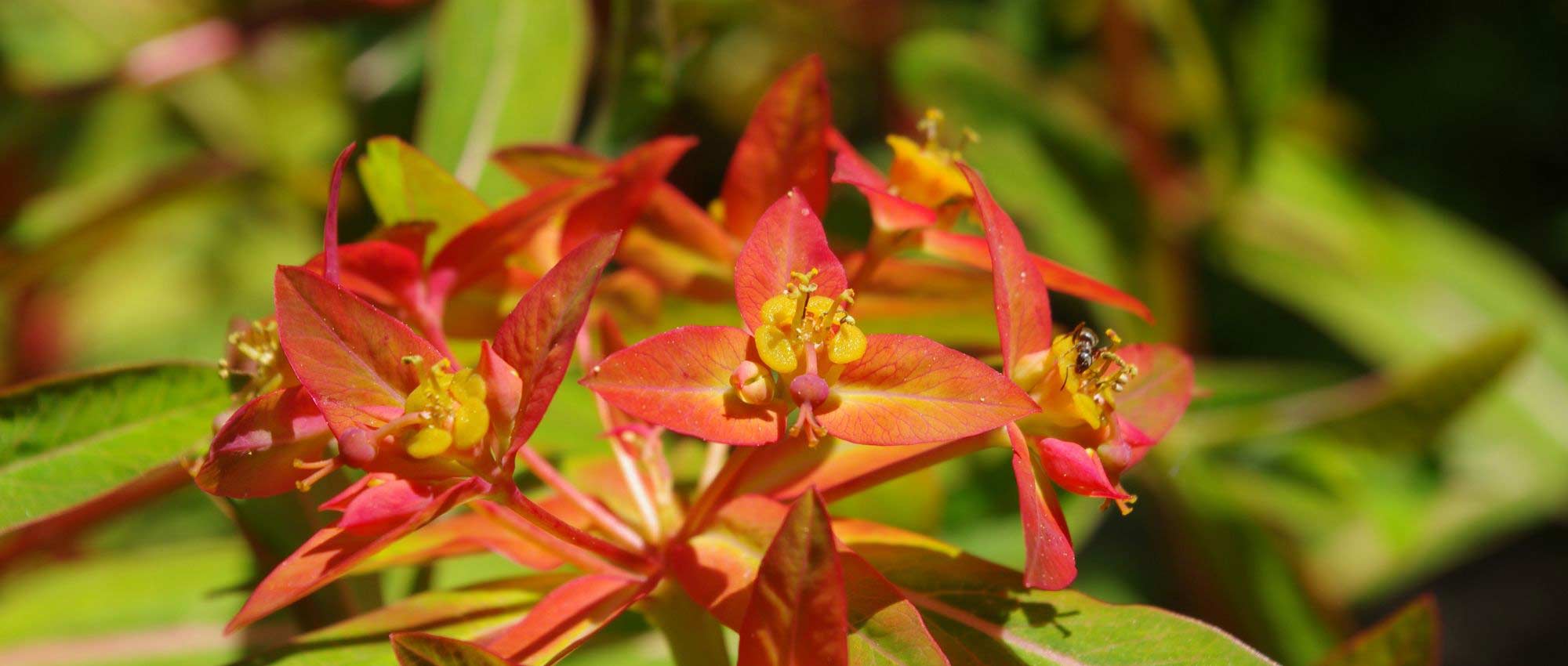
Euphorbias: which variety to choose?
Depending on your situation and preferences!
Contents
Euphorbias form an extremely diverse group of plants, comprising more than 2,000 species, native to widely varied regions worldwide. They therefore display very diverse appearances in foliage, overall shape, habit, flowering… Some are even succulent plants that closely resemble cacti. Euphorbias are notable for very distinctive flowering, often in zesty shades, for example green–yellow. Foliage can also take different colours depending on species: green, glaucous, purple, variegated with yellow or white…
Although most euphorbias thrive in warm, dry situations, others have specific requirements and some can be planted in cool, shaded spots. This advice sheet will help you find which euphorbias suit your situation and preferences! Choose according to exposure, soil in your garden, and effect you wish to achieve.
Which situation is Euphorbia suitable for?
- In full sun, on poor, dry soil
Most spurges thrive in full sun and in well-drained soils that do not retain too much moisture. They benefit from good light and require little water or mineral nutrients. Generally, they grow well in fairly poor ground. This is the case for example with Euphorbia characias, Euphorbia x martinii or Euphorbia myrsinites. They will easily find a place in a sunny border alongside other flowering perennials with colourful blooms (wallflowers, tulips…). Some spurges also develop more attractive colours when grown in full sun!
You can certainly plant these spurges in a rockery, together with succulents (sedums, opuntia, agaves…), and with aromatic or Mediterranean plants. The species that seems most suitable for this use is Euphorbia myrsinites.
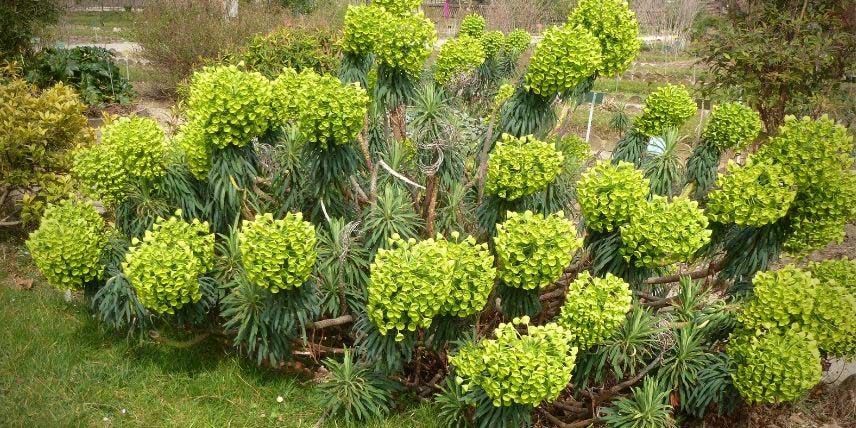
Euphorbia characias subsp. Wulfenii (photo Salix)
-
In woodland or partial shade
Euphorbia amygdaloides, also called wood spurge, occurs naturally in France in deciduous or coniferous forests. It will appreciate being planted in a shady spot in your garden. Similarly, Euphorbia dulcis prefers partial shade. It is valued for its very natural, wild habit. It is also a spurge found growing wild in France. Finally, Euphorbia polychroma will also thrive in lightly shaded situations. Its yellow flowering will bring plenty of brightness!
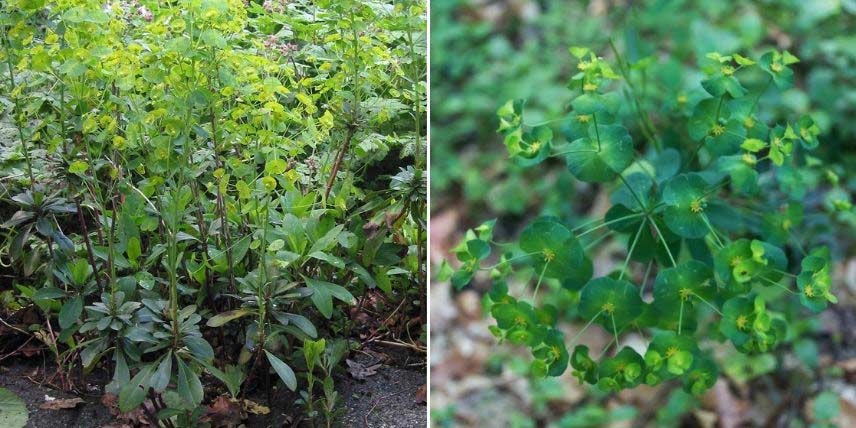
Euphorbia amygdaloides (photos Rasbak and Daniel Villafruela)
-
On fresh or wet soil
Euphorbia palustris, marsh spurge, is particularly suited to wet soils. It is a superb spurge with upright stems covered in elongated leaves and topped by yellow-green inflorescences. It has a very natural, wild appearance!
On fresh but not waterlogged soil, you can also grow Euphorbia amygdaloides, which grows naturally in woodland.
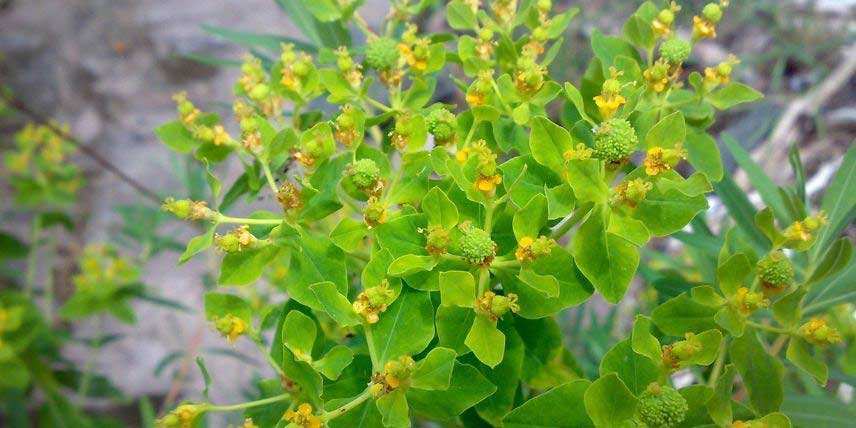
Euphorbia palustris (photo Bjoertvedt)
-
In a pot, in a container planting
For container planting, we recommend annual spurges, ‘Diamond Frost’ or ‘Diamond Cloud’. They are prized for the countless small white flowers they produce. You can combine them with colourful blooms such as Pelargoniums, Calibrachoas or Petunias, and with decorative foliage from heucheras and ipomoeas.
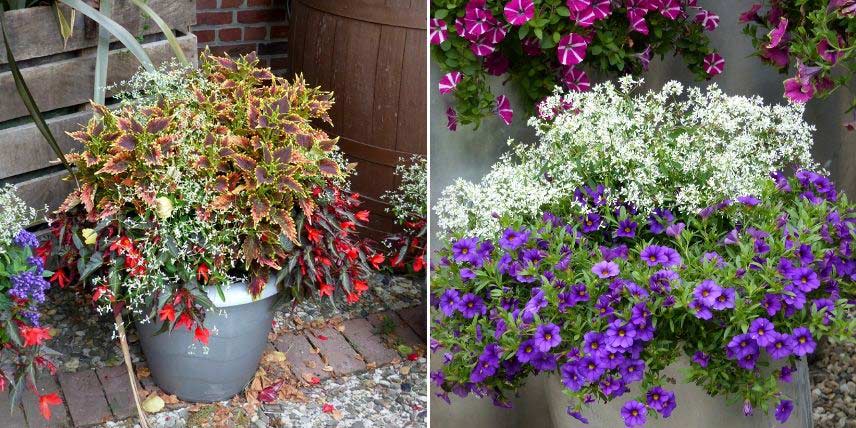
Annual spurge can easily be planted in a pot and pairs well with colourful foliage and blooms. Here, variety ‘Diamond Frost’.
Euphorbia: which garden style?
-
For a very exotic border
To create an exotic, transportive effect, we recommend Euphorbia characias. It is prized for its upright stems bearing numerous bluish leaves, topped by striking green–yellow inflorescences. It is a graphic plant that stands out for its original, unusual shape! Euphorbia griffithii, on the other hand, charms with its bright, luminous orange flowering. It pairs easily with castor oil plants, wallflowers, phormiums and palms to create a superb exotic atmosphere.
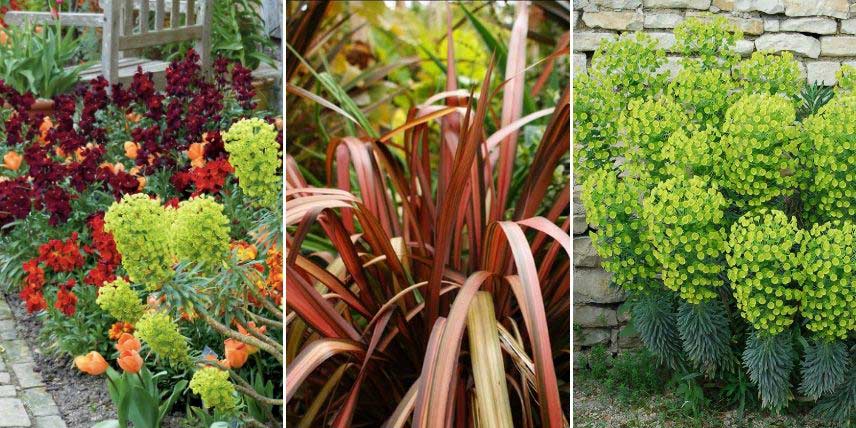
Scene with Euphorbia characias ‘Wulfenii’, wallflower ‘Bedder Scarlet Vulcan Brune’ and tulips / Phormium ‘Pink Panther’ / Euphorbia characias (photo Michel Chauvet)
-
For a natural, wild garden
You can choose Euphorbia palustris, or marsh spurge. It thrives in rather moist soils. It produces long stems bearing pale green leaves and, at the top, beautiful green–yellow inflorescences.
Another option is wood spurge, Euphorbia amygdaloides, which has upright stems with foliage usually dark green, sometimes purple-tinged (Euphorbia amygdaloides ‘Purpurea’), and a pale green flowering.
Both these spurges, E. palustris and E. amygdaloides, grow wild in France! You can plant them at the foot of large leafy trees together with wild garlic, brunnera, daffodils and ferns. When in your garden, these plants will give the impression of a real walk in the forest!
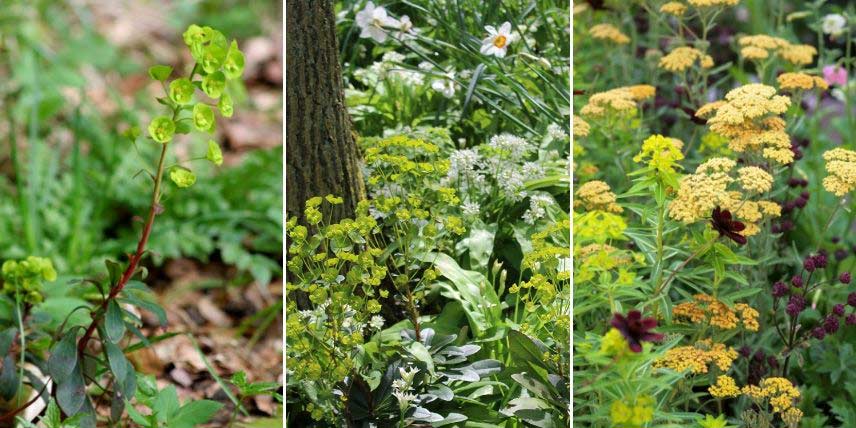
Euphorbia amygdaloides (Enrico Blasutto) / Scene with Euphorbia amygdaloides var. robbiae, Allium ursinum and daffodils / Scene with Euphorbia schillingii, Astrantia, Cosmos and Achillea
-
For a dry Mediterranean-style garden
As many spurges appreciate full sun and free-draining soils, you can use them to create a Mediterranean-style border. Choose Euphorbia myrsinites, also called Corsican spurge, which produces small creeping stems covered with thick, short grey-blue leaves. It is also ideal in rockeries! You can pair it with sedums, Eryngium, houseleeks and small grasses such as Stipa tenuifolia.
For a Mediterranean garden, you can also choose Euphorbia characias, which surprises with its original style: upright stems bearing bluish leaves topped by green-yellow inflorescences.
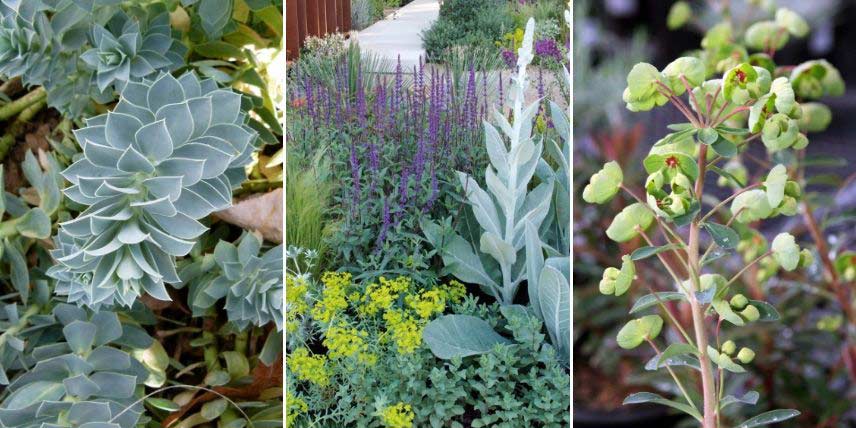
Euphorbia myrsinites / Scene with Verbascum ‘Polarsommer’, Salvia nemorosa ‘Caradonna’ and Euphorbia myrsinites (photo Nathalie Pasquel – MAP) / Euphorbia martinii (photo David J. Stang)
Discover other Euphorbia - Spurge
View all →Available in 1 sizes
Available in 4 sizes
Available in 1 sizes
Available in 1 sizes
Available in 1 sizes
Available in 1 sizes
Available in 1 sizes
Available in 1 sizes
Available in 1 sizes
Available in 1 sizes
Euphorbia: what visual effect?
-
For vivid, colourful flowering!
Some spurges stand out for their very colourful hues. Euphorbia griffithii, for example, has foliage green tinged with purple, red stems and above all an orange, very vivid flowering. These warm tones catch the eye and bring dynamism to the garden. We particularly recommend variety ‘Dixter’, with truly flamboyant colours.
Euphorbia polychroma also produces a vivid yellow-green flowering. Its zesty, luminous hue is very appealing.
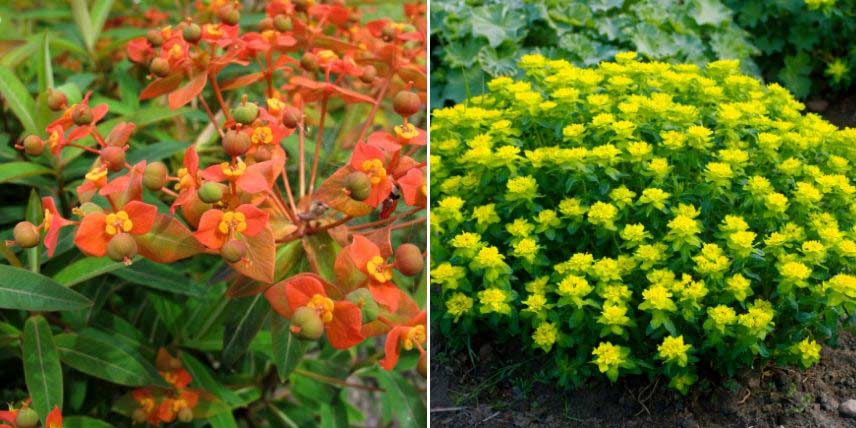
Euphorbia griffithii (photo Helena H) / Euphorbia polychroma
-
For very delicate, airy flowering
In pots, alongside plants with colourful flowering, do not hesitate to include Euphorbia ‘Diamond Frost’. Very different from other spurges, this one bears numerous small white flowers, extremely light. It produces a very airy flowering, evoking tiny white butterflies. It really showcases other flowerings, such as those of begonias or petunias. It adds a little extra that lightens very vivid flowerings, which otherwise could become heavy and overwhelming. It can also be planted in the ground with other perennials for a fairly natural-looking border.
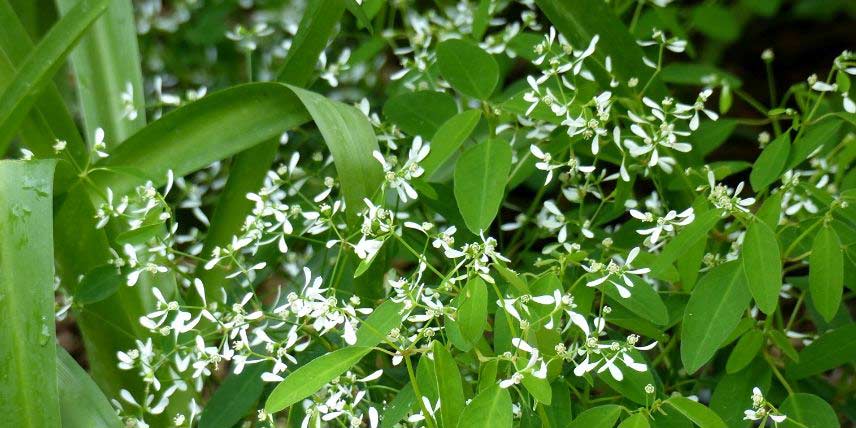
Annual spurge ‘Diamond Frost’
-
For colourful foliage that adds contrast
Some spurges have colourful, unusual foliage. Discover in particular Euphorbia ‘Ascot Rainbow’, which is truly impressive for its green and yellow foliage, with young shoots tinged red and orange… An exceptional blend of hues!
Spurges with foliage variegated in cream-white or yellow, Euphorbia characias ‘Tasmanian Tiger’ or Euphorbia characias ‘Emmer Green’ are ideal for brightening a border and creating contrast alongside darker plants, such as Ophiopogon planiscapus ‘Nigrescens’ or some heucheras.
Conversely, you can also make bright flowerings stand out by planting beside them a spurge with dark foliage (Euphorbia ‘Black Bird’ for example, or Euphorbia amygdaloides ‘Purpurea’).
Finally, if you want blue-grey foliage, choose Euphorbia myrsinites, or Corsican spurge.
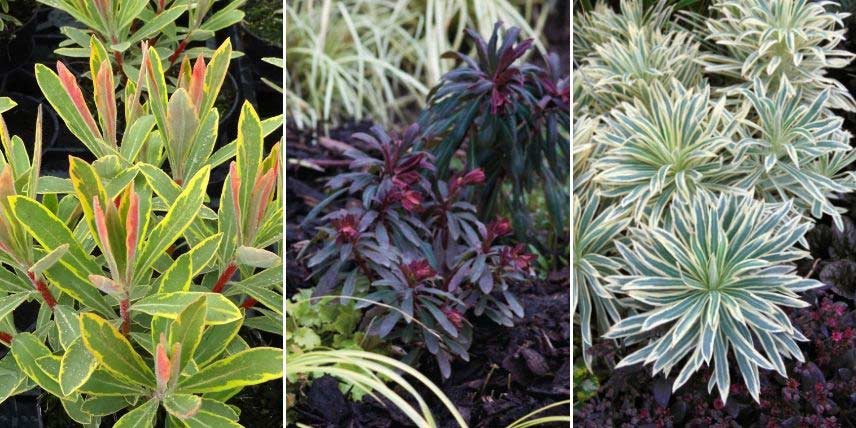
Euphorbia ‘Ascot Rainbow’, Euphorbia amygdaloides ‘Purpurea’, Euphorbia characias ‘Tasmanian Tiger’
- Subscribe!
- Contents
































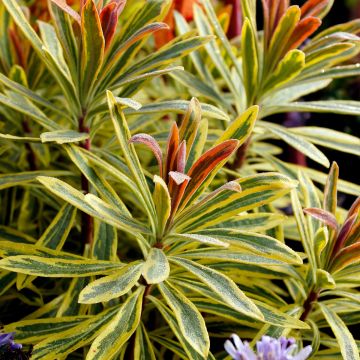
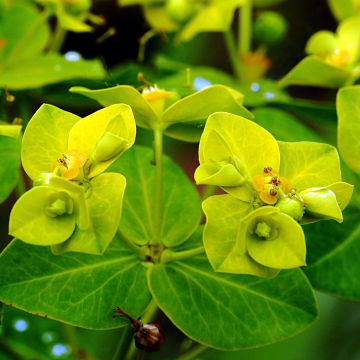
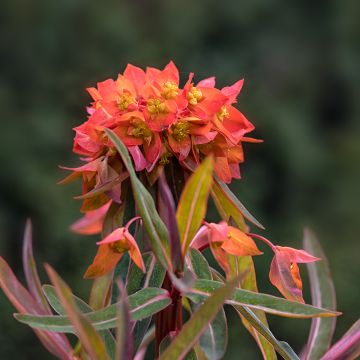
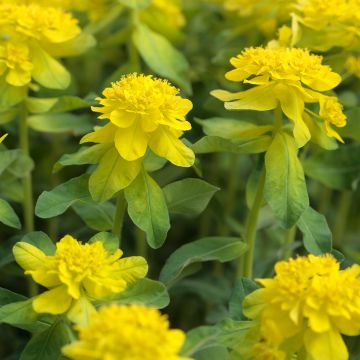
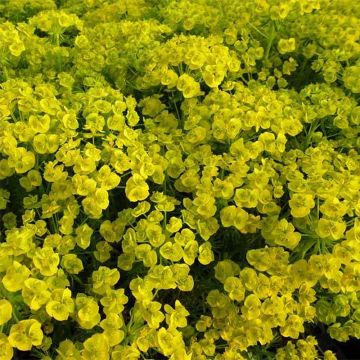
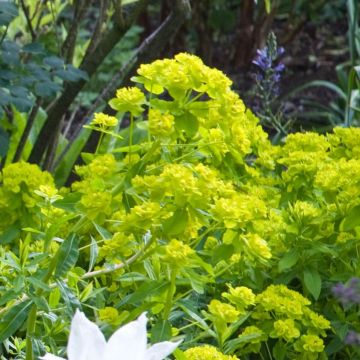


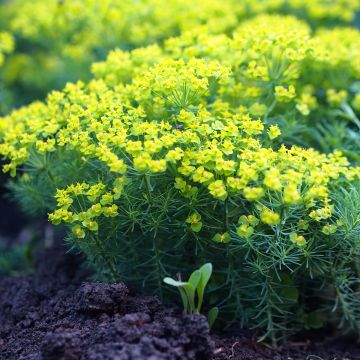
Comments